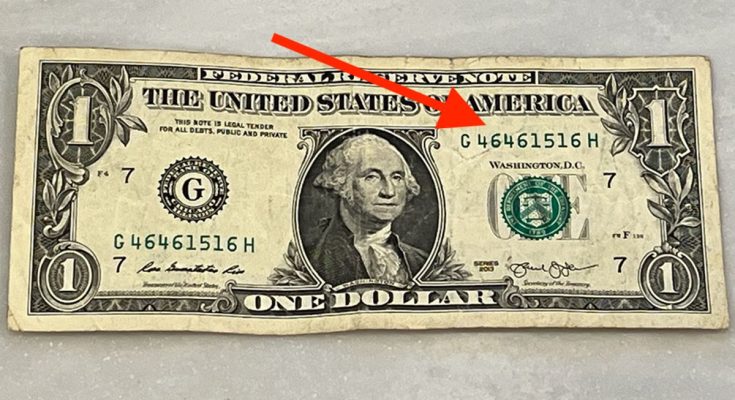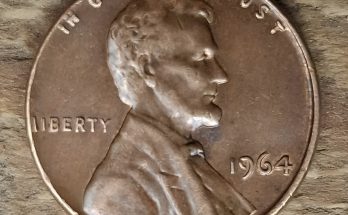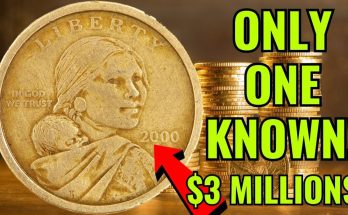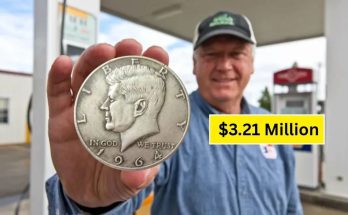The image shows an ordinary $1 bill — something millions of people carry in their wallets every day. But look closer, because what might seem like a simple dollar could actually be worth thousands of dollars to collectors. The red arrow in the photo points directly to the serial number, one of the most important and overlooked details on U.S. currency. It’s this number that can turn a common one-dollar note into a highly valuable collectible, potentially worth up to $10,000 or more depending on its rarity and pattern.
The dollar bill in the image is a Series 2013 Federal Reserve Note featuring the familiar portrait of George Washington at the center. The note includes the standard security features — the Federal Reserve District seal, the Treasury Department seal, and the serial number printed twice in green ink. The specific serial number shown here is G46461516H, and it’s highlighted by the large red arrow to draw attention to where collectors should always look first when checking for valuable bills.
Most people never notice that the serial numbers on U.S. currency can sometimes contain unique or rare patterns that make them highly sought after by collectors. These special patterns are known as “fancy serial numbers,” and they are what transform a normal $1 bill into a collectible item worth far more than its face value.
Here are some of the most desirable serial number types collectors search for — and why they can be worth thousands:
-
Repeater Notes – These have a repeating pattern, like 12341234 or 46464646. The symmetry and rarity of these notes make them extremely collectible.
-
Radar Notes – A “radar” serial number reads the same forward and backward, like 12344321 or 46666464. These are among the most popular and valuable types of fancy serials because of their visual appeal and balance.
-
Solid Notes – These are the rarest of all, with all digits the same, such as 11111111 or 77777777. Only one in every 100 million bills has such a number, making them incredibly hard to find and worth thousands.
-
Binary Notes – Made up of only two digits, such as 01010101 or 34343434. Binary notes are collectible, especially when they also form repeating or radar patterns.
-
Ladder Notes – These feature numbers in perfect ascending or descending order, like 12345678 or 87654321. Perfect ladders are very rare and can fetch high prices, depending on condition.
-
Low Serial Numbers – Bills that begin with several zeros, such as 00000025, are valuable because they were among the first printed in that series.
-
High Serial Numbers – Notes ending in numbers close to 99999999 can also attract collectors who seek the final notes in a print run.
-
Star Notes – When a bill is misprinted at the Bureau of Engraving and Printing, it’s replaced with a note bearing a small star next to the serial number. Star notes are replacements for defective currency and are printed in smaller quantities, making them rarer and more collectible.
In this photo, the red arrow emphasizes the location of the serial number, reminding collectors and casual observers alike to inspect their bills carefully before spending them. What may appear to be a regular dollar bill could actually have a rare serial pattern that turns it into a small fortune.
For example, a $1 bill with a solid serial number such as 77777777 has sold for over $5,000, and binary radar notes can reach prices between $2,000 and $10,000 at auction. Even notes with simpler patterns like 12344321 (a radar) or 45454545 (a repeater) can sell for hundreds of dollars, especially if they are crisp and uncirculated.
Collectors pay particular attention to condition — the fewer creases, folds, or signs of wear, the higher the note’s value. A “crisp uncirculated” bill (often abbreviated as CU) commands the best price. Notes in circulated condition, like the one shown in the image, can still be worth more than face value if the serial number is exceptional.
Another interesting category is “birthday notes”, where the serial number resembles a date — for example, 07041776 (July 4, 1776, the date of American independence) or 12251989 (December 25, 1989). Collectors and even casual buyers often pay premiums for notes that correspond to significant historical or personal dates.
This makes it worthwhile to check every bill that passes through your hands. While it’s rare to find a note worth thousands, stories abound of people discovering valuable bills in circulation. In some cases, collectors have found radar notes or star notes in change from everyday transactions.
The image and caption emphasize an important message: don’t underestimate the power of the serial number. Every bill tells its own story, and sometimes, that story includes a hidden fortune. The U.S. dollar may be the most recognized currency in the world, but within its details lie opportunities for discovery that few people notice.
When checking your bills, always look at both serial numbers on the front of the note — they must match exactly. Also note the letter prefix and suffix (such as the “G” and “H” in this image), which indicate the Federal Reserve Bank and print sequence. If your bill’s serial number fits into any of the collectible categories listed above, it could be worth hundreds or even thousands of dollars depending on rarity and condition.
This photo perfectly captures the excitement of currency collecting: a simple object from everyday life that hides the potential for incredible value. The bold red arrow pointing to the serial number acts as a reminder — check your bills before spending them! You might just be holding a small piece of American money history worth far more than one dollar.



